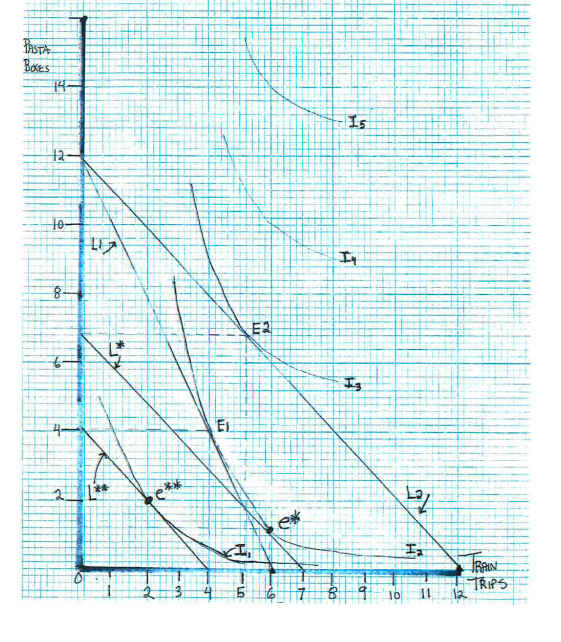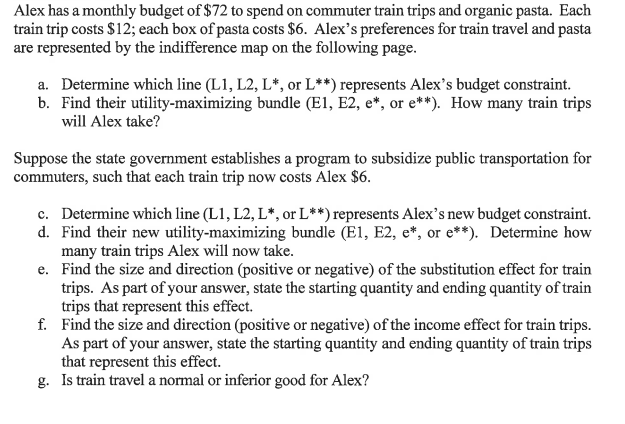Suppose the state government establishes a program to subsidize public transportation for commuters, such that each train trip now costs Alex $6. c. Determine which line (L1, L2, L*, or L**) represents Alex's new budget constraint. d. Find their new utility-maximizing bundle (E1, E2, e*, or e**). Determine how many train trips Alex will now take. e. Find the size and direction (positive or negative) of the substitution effect for train trips. As part of your answer, state the starting quantity and ending quantity of train trips that represent this effect. f. Find the size and direction (positive or negative) of the income effect for train trips. As part of your answer, state the starting quantity and ending quantity of train trips that represent this effect. g. Is train travel a normal or inferior good for Alex?
Suppose the state government establishes a program to subsidize public transportation for commuters, such that each train trip now costs Alex $6. c. Determine which line (L1, L2, L*, or L**) represents Alex's new budget constraint. d. Find their new utility-maximizing bundle (E1, E2, e*, or e**). Determine how many train trips Alex will now take. e. Find the size and direction (positive or negative) of the substitution effect for train trips. As part of your answer, state the starting quantity and ending quantity of train trips that represent this effect. f. Find the size and direction (positive or negative) of the income effect for train trips. As part of your answer, state the starting quantity and ending quantity of train trips that represent this effect. g. Is train travel a normal or inferior good for Alex?
Chapter3: Preferences And Utility
Section: Chapter Questions
Problem 3.7P
Related questions
Question
ONly parts D-G

Transcribed Image Text:Bokes
Is
12
It
E2
Is
EL
**
RAIN
TRIPS
16

Transcribed Image Text:Alex has a monthly budget of $72 to spend on commuter train trips and organic pasta. Each
train trip costs $12; each box of pasta costs $6. Alex's preferences for train travel and pasta
are represented by the indifference map on the following page.
a. Determine which line (L1, L2, L*, or L**) represents Alex's budget constraint.
b. Find their utility-maximizing bundle (E1, E2, e*, or e**). How many train trips
will Alex take?
Suppose the state government establishes a program to subsidize public transportation for
commuters, such that each train trip now costs Alex $6.
c. Determine which line (L1, L2, L*, or L**) represents Alex's new budget constraint.
d. Find their new utility-maximizing bundle (E1, E2, e*, or e**). Determine how
many train trips Alex will now take.
e. Find the size and direction (positive or negative) of the substitution effect for train
trips. As part of your answer, state the starting quantity and ending quantity of train
trips that represent this effect.
f. Find the size and direction (positive or negative) of the income effect for train trips.
As part of your answer, state the starting quantity and ending quantity of train trips
that represent this effect.
g. Is train travel a normal or inferior good for Alex?
Expert Solution
This question has been solved!
Explore an expertly crafted, step-by-step solution for a thorough understanding of key concepts.
Step by step
Solved in 2 steps

Knowledge Booster
Learn more about
Need a deep-dive on the concept behind this application? Look no further. Learn more about this topic, economics and related others by exploring similar questions and additional content below.Recommended textbooks for you







Exploring Economics
Economics
ISBN:
9781544336329
Author:
Robert L. Sexton
Publisher:
SAGE Publications, Inc

